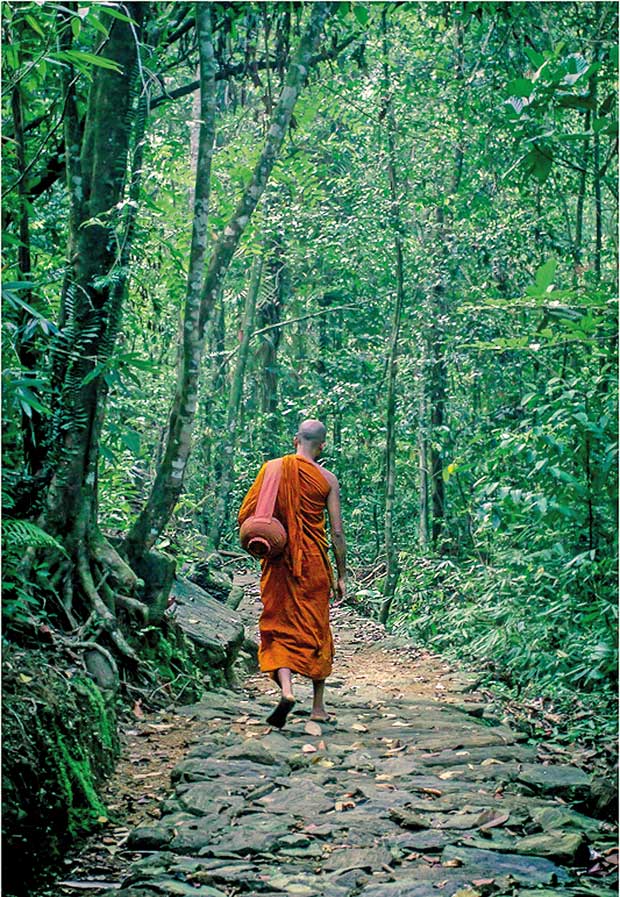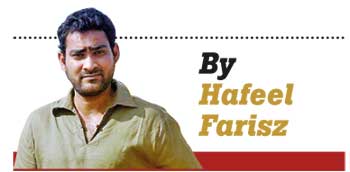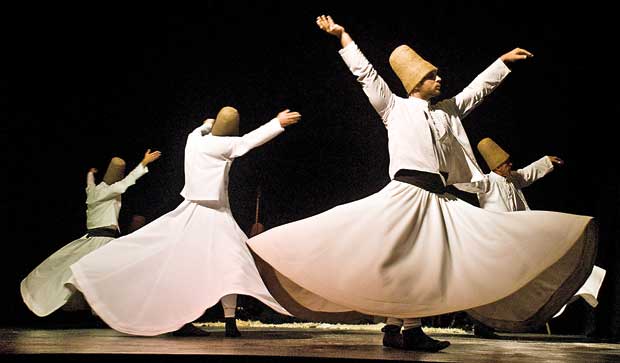Reply To:
Name - Reply Comment
Last Updated : 2024-04-26 18:26:00

“Do not go upon what has been acquired by repeated hearing; nor upon tradition; nor upon rumour; nor upon what is in a scripture; nor upon surmise; nor upon an axiom; nor upon specious reasoning; nor upon a bias towards a notion that has been pondered over; nor upon another’s seeming ability; nor upon the consideration, ‘The monk is our teacher’. Kalamas, when you yourselves know: ‘These things are bad; these things are blamable; these things are censured by the wise; undertaken and observed, these things lead to harm and ill,’ abandon them” they were preached.
Attempting to understand the unknown and the unfathomable has always been a childhood preoccupation. Was the concept of God, the omniscient, omnipotent, omnipresent creator of the world according to religious teachings, human: as petty and arrogant and as the literal interpretation of scripture and ritual would have us believe? Was Nirvana an ideal beyond definition although words have posited it within reality, the place in which the two or three dimensions of consciousness evaporates into the transcendental? What does it really mean to meet God? What did it really mean to attain Nirvana? Were there similarities between the four stages of attaining a truth beyond the ‘self’, in Islam defined as “Sharia” (universal truth/ not to be confused with the term used to describe a man-devised archaic legal system), “Thariqa” (phase in which the seeker becomes aware of inner guidance), “Haqiqa” (where the seeker understands the nature of being, and is transcendentally in communion with nature), and “Marifa” (Ultimate attainment of being-where the self is one with its universal nature), and in Buddhism defined in the concepts of Sovan, Sakrudagami, Anagami and Arahath? Or the more pertinent question as to if such attainment, “Arahath” or “Marifa”, posits the being into the realm of “Nirvana” or in Islam the realm of “Fanaa” (the passing away of the self, the  entry into non-existence, thereby, becoming absolute existence) were actually the same stages described in different words? To any follower of these spiritual strands there is very little to distinguish from.
entry into non-existence, thereby, becoming absolute existence) were actually the same stages described in different words? To any follower of these spiritual strands there is very little to distinguish from.
If not, were they all pure concepts through which the other- the unknown was explained. Was such explanation beyond reach of the human mind or are they in fact in reality attainable, remain questions that have continued the childhood preoccupation. I had understood at an early age, that organized religion, be it couched in terms of philosophy or way of life, nationalism and pride were concepts through which identity was created and control was exerted. It was the genetic accident of birth that determined them. Death, the ultimate end -- is where the questions arise, and from time immemorial human beings have devised various formulae to explain to themselves the two biggest mysteries of life: Why are we here? What happens after death? Two questions which no amount of theology, religion, or philosophy have yet been able to provide answers to.
Today, religions thrive in the very fact that such answers have not been provided. But they counter it with certainty, a sense of convoluted paranoia and certainty which the intellect doesn’t, could not, and ideally should not perceive. The certainty has evolved into an unbridled conviction which adherents of close to 4000 religions across the globe believe they are right, convinced that every single one of the others is wrong. The same certainty with which the men of yore concluded smallpox was a disease from God, or was a result of ‘Karma’ and therefore asserted with certainty that finding a solution was going against the will of God or nature. Cures were found for smallpox and for many other diseases, which according to many who denounced the research for a cure, ‘emanated from ‘God’ or was a result of ‘Karma’. Be it the concept of heaven and hell or reincarnation, in explaining life after death -- human beings of either spectrum have convinced themselves that they are aware of an ultimate truth and believe it with certainty. But therein lies the oxymoron. Belief is a paradox in itself and an absurd one at that. ‘Belief’ stems from insecurity. If one was to know something as true or fact, there is no need of ‘belief’. We don’t ‘believe’ that the sun will rise in the morning. The sun will rise in the morning, as it has for the millions of years before us. One needs to ‘believe’ or have ‘faith’ only when one is uncertain. Accordingly although belief/faith is a product of knowledge and social construct it inherently contains the possibility of uncertainty: the possibility of ‘disbelief’, as Hazelton so eloquently describes.
The human mind is constantly in search of a linear narrative: attempting to make sense of what is and what is not is a constant preoccupation. While the ascetic Muslims recitals and chants remained the symbol of the path towards knowledge, the Buddhist monk remained the symbol in the quest for such knowledge, to me.
As much as the spiritual quest remains, the hope for political salvation -- the material (loukika) seems further and further away. Since the end of a bloody war, in which one side were named the victor, Sri Lanka has driven herself into turmoil. The war remained the constant through which the human minds need for the ‘other’ was embodied. The end of it signified the beginning of the material mind to find another ‘other’. This was for the essential materialist, who unfortunately took the helm in the need to find the other -- with the saffron robes intact, the robes which were to the larger world and those at home -- the symbol of tranquillity and equanimity. While the majority of the country slept in peace, there remained the mind which didn’t. A mind which runs amok, and meanders in constant paranoia. A paranoia driven by hate and fuelled by vengeance. It would be foolish to think that this mind is confined to the undermentioned, but they were the visible frontier of fearmongering and hate fuelling.
What was essentially a movement which gathered pace due to the support by the urban businessmen to counter- what they perceived the new ‘others’ encroachment in their endeavours -- has over time evolved into a paranoia that has been solidified in public consciousness. The movements’ initial slogans drew parallels with the calls in Nazi Germany. “Boycott” the shops owned by Muslims. Only yesterday, social media was rife with ‘news’ which said a Muslim-owned store had sprayed female underwear in an attempt to curtail birth rates of Sinhalese women, and thus called for the immediate boycotting of the store. This is not a new cry, and has been a consistent tag line since the inception of the movement. Of course this tag line is not based on fact or evidence, mass hysteria often isn’t.
It is those that possess or justify such paranoia- that fall within the ambit and scope of the definition of the Post War Sinhala Buddhist (PWSB), coined in the previous essay. The racist, bigoted xenophobe who found salvation at the annihilation of one enemy and had to create another. It attempts to define, a militarist, fascist and loud movement, the likes of which the nationalists’ movement pre and post colonialism had not seen. This as detailed previously, does not include nationalists Sinhalese who are protective of the only Sinhala Buddhist state in the world and who cherish its identity remaining so. Only the extreme and the warped could use such clear distinction provided in the previous essay to further and distort it to include the definition to mean “All Sinhala Buddhists who live in post war Sri Lanka”. The distinction between Buddhism as a philosophy, to use the closest western adjective, and Sinhala Buddhism as a political embodiment is also understood. However, the ‘Post War Sinhala Buddhist’, as defined, supersedes these boundaries. If Nietzsche, Orwell, Hegel or even Trotsky were to analyse this phenomenon they would be marvelled at the usurpation of what they termed ‘nationalism’. It remains the only term through which, monks in Saffron Robes, laity, and the educated but post war emboldened fascist could be described. As such it’s used to define the fascist tendencies of a movement that continues to gain ground, largely among Sinhala Buddhist youth active on social media.
Was this fearmongering without good reason, and have the Muslims always been the innocent victim seem to be the questions that are asked. If one was an observant reader of my previous columns in these pages, the reader would be aware of the detailing and description of the threat posed by Islamic fundamentalism. The need to address such is incumbent upon the Muslim intellectuals, and intelligentsia which have over the years not been active in curtailing the fundamentalism as would have been ideal.
There remains a section of the Lankan Muslim polity, who in their carved realms, believe that a strict literal interpretation of scripture, practice and ritual is required -- and in their outward expression of such conviction -- have sympathized with the actions of the Islamic State (IS), justified the whipping of a Muslim girl in Puttalam, and banished a female poet from the East who called for the legalization of Prostitution, among others.
I use these examples as symbols, which are in no way meant to confine these expressions only to the above. The demand that is now in the public domain, dominated by a section of the males within the Muslim community, is to continue the validation of an archaic and pre modern aspects of a law which should and could have no place in modern society. A law ideally which should have been abolished decades ago, all stemming from a warped interpretation of scripture. It is this same interpretation that has resulted in the rise in the adorning of the Niqab -- a pre Islamic costume of the Hejaazi desert in which Islam was born. It would however, be naïve to believe that these interpretations were suddenly thrust upon the Muslims of Sri Lanka. The Iraqi invasion, and the resultant constant conflict the Middle East have been engulfed in, have most certainly had its impact. For if one’s belief is not providing answers to the sufferers as promised: they are not adhering to the faith in the manner prescribed and the suffering is as a result of this non adherence- is almost always throughout history, the narrative that is put forth to believers of any religion. The Wahabi and Salafist networks spearheaded by Saudi Arabia and ably funded by Qatar, supported by the American empire has drawn support as a result of this perceived lack of ‘adherence’.
“God’s wrath falls on us because we are straying away from God” is the cry through which the educated and the uneducated confine their intellectual prowess and resort to literal interpretations. This is true of Sri Lanka presently. The international and sectarian dynamics of the violence in the Middle East is not addressed in this essay but these warped interpretations have, in the existing political context of the Middle East resulted in “Killing in the name of God”. Such is the power of ignorance and blind faith. Again, this is not the sole construct of the adherents of the Islamic faith. Throughout history symbols, religion, and nationalism have been usurped by different sects, religions, and fascists to further their perverted narratives.
But there is a point that needs to be made. On social media there run many photographs of “Pre and Post – Libya, Iran, Iraq, Afghanistan” etc. Often times those who share these photos are under the mistaken belief that the Muslims occupied these countries in the 1990’s after which all liberalism vanished. That again reeks of pure ignorance. All these countries, formed an integral part of the early conquests and for centuries were under Muslim rule, with all forms of religious expression, individual freedom intact as was possible during those times of rule -- until the ‘Talibanisation’ of that part of the world. The threat to curb such liberalism, culturally, has taken roots in parts of Sri Lanka, within sections of the Muslim community.

It is this strict literal interpretation that must be fought ideologically, because -- the literal interpretation of text, practices and rituals -- is the source, and the source must be addressed.
A clear way of which is to understand and educate on the socio politics of religion, theology, history and most importantly the evolution of the different stages of the interpretation of the text, practices and rituals.
Education into these areas and socio, economic and political conditions which propelled the interpretations in the past, is the most potent way of addressing and overcoming the existing fundamentalism. Denial after denial of such fundamentalism only symbolizes ignorance. To any observer, there is a visible shift in the actions and attitudes of a growing section among the Muslims in Sri Lanka.
However, do these interpretations and practices warrant such violent reaction from a section of the majority -- identified as the PWSB? As detailed in my previous essay it does not. It does not call for such a violent, alienating and exterminating threat. The real victims as of now, are the Muslims themselves and the fundamentalism that is espoused among a section of the Muslim polity in Sri Lanka has got very little, if nothing, to do with the State or the annihilation of Sinhala Buddhists and other races. Instead it seeks to confine and limit the expressions and practices of the Muslims. But the fearmongers are fascists, who believe in the annihilation of every other different race and culture which exist in the country. The excuse, for them, an excuse which has been fed down to evolve into mass consciousness is ‘fundamentalism’ among the Muslims. But that excuse reeks of hypocrisy and deceit. If those shouting their throats hoarse with anti-Muslim hate were altruistic, the need of the hour would be to help the Muslim community address these issues. Instead the threat of annihilation is on all Muslims. “Let’s start from Maligawatte and finish them all off”-- was the cry. The fascism has extended beyond too. There is a constant call by these fascists for the rest of the communities to ‘fall in line’, culturally. The beauty of Sri Lanka rests in its diversity and as one of the unintended heroes of the PWSB, Lt. Gen Daya Ratnayaka points out “The beauty of this country is that in the same street you have a Temple, a Kovil, a Mosque and Church. That is the identity of this country”. The PWSB doesn’t not understand that the likes of Gen. Ratnayaka, a proud nationalist, among many others do not condone the fascism sprouted by this loud movement.
However, it is these tendencies of intolerance, forcefulness and rigidity which lead to the conclusion that the PWSB and the Muslim Fundamentalist are in fact, two sides of the same coin. Constantly feeding each other in their warped endeavours, silencing the inclusive moderates, advocating and creating suspicion among the two communities. Although the end goal seems different, the results are one and the same.
I don’t find the need to respond to the recent ‘response’ to my previous essay rife with selective statistics picked out from thin air, and interpretations given out like a bigoted justifier of violence would- covering the fascism with the excuse of ‘fundamentalism’. But I remind the Kalama Sutta to the PWSB, to question the fascist narrative put forth, and to the Muslims, I reintroduce the intellectual powerhouses which formed the bedrock of Islam, Ibn Rushd, Ibn Arabi, Ibn Kuldoom Ibn Sina, Sarraj who wrote the famed ‘ Kitab Al Luma’ (Book of Flashes) or the 9th century mystic Junaid, among many others, who kept true to the spirit of the transcendental zeal and questioned the nature and the beauty of the mystery that is the ‘Universe’ and explored the concept of God. They did not blindly believe in a human like interventionist man up in the sky who insists on reward and punishment, with a notebook in hand hovering over the mundane day to day activities of humans, who are only a minute fraction among the vastness of the creation. Such a concept at best describes no one but an insecure dictator of a third world state.
Thamara Tuesday, 29 November 2016 10:06 AM
Very interesting article should be read by all. Dear editor please translate this into Sinhala l and publish it in Lankadeepa so that the sinhala readers can also be educated. Thank you.
U Vijitha Friday, 11 October 2019 09:32 AM
Please translate and publish this in Lankadeepa too, so that everyone can read.

Add comment
Comments will be edited (grammar, spelling and slang) and authorized at the discretion of Daily Mirror online. The website also has the right not to publish selected comments.
Reply To:
Name - Reply Comment
US authorities are currently reviewing the manifest of every cargo aboard MV
On March 26, a couple arriving from Thailand was arrested with 88 live animal
According to villagers from Naula-Moragolla out of 105 families 80 can afford
Is the situation in Sri Lanka so grim that locals harbour hope that they coul

12 minute ago
2 hours ago